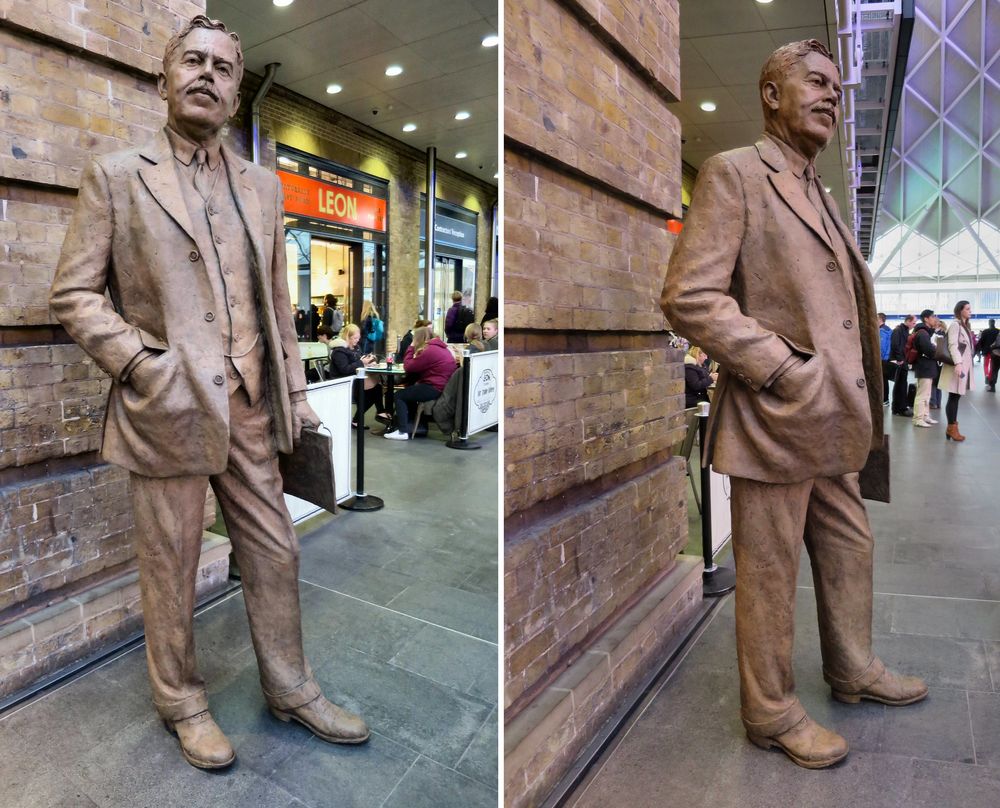There is a bronze statue of British railway engineer Sir Nigel Gresley towering over passengers as they pass through London King's Cross railway station. Sir Gresley was the engineer behind the Flying Scotsman, the first steam locomotive to break the 100 mph barrier and the famous Mallard, that still holds the record for being the fastest steam locomotive in the world. Sir Nigel Gresley might not be as admired as Isambard Kingdom Brunel, but his contribution to the development of the steam locomotive cannot be ignored. And his statue at King's Cross railway station would have been hard to miss had the original design been honoured.

Photo: Alan Stanton/Flickr
The story of the statue began in 2012 when the Gresley Society, a charitable organization of around 500 members dedicated to the preservation and celebration of the work of Sir Nigel Gresley, received a princely sum of half a million pound by bequest from a society member. The society decided to allocate a part of the fortune on a memorial, a statue. The sculptor Hazel Reeves was commissioned at a cost of £95,000 and another £13,000 was raised by a public appeal.
Hazel Reeves designed a larger-than-life statue of the celebrated engineer standing 7 feet tall, with his right hand placed inside his jacket pocket, and with his left hand holding a copy of the magazine, The Locomotive, with the front cover showing the Mallard. As a visual pun reminding people of the engineer’s famous achievement, Reeves placed a statue of a mallard duck at the engineer’s feet, starting a bitter dispute that The Guardian called “the most acrimonious argument in the long, pedantic history of the railway hobbyist.”

Model of the statue as envisioned by artist Hazel Reeves with the controversial duck. Photo: The Guardian
The Mallard was, without doubt, Sir Gresley’s finest achievement. With an aerodynamic body atypical of steam locomotives, and a high powered engine, the Mallard was designed for speed. And it proved its worth when it reached 126 mph on 3 July 1938—a record that has not been bested by any steam driven locomotive.
When applying for planning permission, the society’s trust stated: “This duck is no mere whimsy. It is an allusion to Sir Nigel’s most famous locomotive, the Mallard, which holds the world speed record for steam locomotives. It is also an allusion to Sir Nigel’s habit of feeding mallards at his prewar home in Salisbury Hall.”
But Gresley’s family disapproved the duck. Tim Godfrey, the grandson of Gresley who is also the society's vice-president, told the society in a meeting that they would have to keep the duck off if they “wanted to keep good relations with the Gresley family.”
“It’s a statue of a man, not a stupid duck,” Tim Godfrey had reportedly protested. Oddly, Godfrey himself is a breeder of rare ducks.

The Mallard. The fastest steam locomotive in the world. Photo: P.A.King/Flickr
The Society was divided on the duck. At a meeting on March 2015, three members of the society resigned after failing to persuade their colleagues that the duck should stay. Some pro-duck members started an online petition and managed to collect more than three thousand signatures.
“Which is the statue that you are going to take your grandchildren to see?” asked duck supporter Vanessa Feltz. “Which is the statue that you will make a pilgrimage to see; which is the statue that you will take a picture of yourself next to: the one with the duck or the one without it? I’m 100% pro-duck.”
In the end, the statue was erected near the booking office of London King's Cross railway station, but without the duck. Duck-supporters attended the unveiling carrying rubber ducks and duck balloons to voice their protest.
Libby Ranzetta, a leading member of the pro-duck faction, Gresleyduck.org, warned that refusing to respect the people’s wishes might lead to people “leaving their own duckish tributes at Sir Nigel’s feet”, which the society might come to regret later.
Ranzetta told the Observer: “I can’t condone the placing of tribute ducks near Sir Nigel’s feet because that really will detract from the dignity of the statue but, to be honest, a little part of me would be delighted to see them there in perpetuity. They’d certainly bring attention to Gresley and his achievements – and annoy the hell out of the po-faced philistines who run the Gresley Society.”

Photo: Matt Brown/Flickr
References:
# Ian Jack, Duck and cover: there’s no row like a railway enthusiasts’ row, The Guardian
# Jamie Doward, Memorial to man who made the Mallard runs into row over a duck, The Guardian
# Mike Amos, Statue of limitations, there’s outrage that the bird has flown, The Northern Echo



Comments
Post a Comment